Dutasan Mountain (두타산)
0m 33662 2021-04-02
Duta-ro, Samcheok-si, Gangwon-do
+82-33-570-3424
Standing at 1,357 meters above sea level, Dutasan Mountain is a major mountain amid the Taebaeksanmaek Mountain Range. It is especially known for Swinumjeong Pavilion, plunge basin, azalea trees, nut pines, and colorful fall foliage.
Cheoneunsa Temple, where Lee Seung-Hyu resided during his exile, is located in the Samcheok region of the mountain. Lee was the author of Jewang Ungi, a historical poem written in the late Goryeo period. The name “Duta” is a Buddhist term that means "retiring from the world to go on a Buddhist retreat."
Samcheok Yeonggyeongmyo Royal Tomb (삼척 영경묘)
5.0 Km 11294 2022-09-15
Miro-myeon, Samcheok-si, Gangwon-do
+82-33-570-3722
Yeonggyeongmyo Royal Tomb is the grave of the mother of King Mokjo and the 5th great-grandmother of King Taejo of the Joseon dynasty. During the 3rd year of King Gojong’s reign (1899), the grave as well as memorial monuments were built together with Jungyeongmyo, a grave for the 5th great-grandfather of King Taejo. Surrounded by a rich forest, it has a beautiful view. Every April 20th, an ancestral ritual is held by the Lee family (from Jeonju).
Samcheok Cheoneunsa Temple (천은사(삼척))
5.9 Km 14943 2022-02-03
816, Dongan-ro, Samcheok-si, Gangwon-do
+82-33-572-0221
Cheoneunsa Temple is located on Dutasan Mountain in Miro-myeon, Samcheok-si, Gangwon-do. At the tail end of the Goryeo dynasty, Lee Seung-hyu, a renowned scholar, wrote ‘Jewangungi’, an epic for the Korean people at Cheoneunsa temple. After the temple burnt down during the Korean War, the temple was renovated. The temple houses Beophwagyeong (Lotus Sutra Statue) among other cultural significant artifacts. Also, the surrounding area was the capital during Goryeo dynasty, where a number of relics such as pieces of celadon and blue roof tiles were unearthed.
Gwaneumgul Cave (Daei-ri Cave Caverns) (관음굴(삼척 대이리 동굴지대))
7.4 Km 36217 2021-04-23
557, Hwanseon-ro, Samcheok-si, Gangwon-do
+82-33-570-3545
Gwaneumgul Cave has a reputation of being a must-explore cave by not only Korean scientists but throughout cave academia around the world. The entrance of the cave is 4.2 meters wide, 3 meters high and 1.6 kilometers deep. The underground water flows from the entrance all the way to end all year long producing approximately 15,000 ㎥ per day. The cave also has 4 waterfalls along the way with the largest being 9 meters high. The cave is full of stalactites and stalagmites, as well as straw soda, columns, flowstones, cave corals, aragonite crystals and more. The cave has a total of 24 different types of living organisms, making a desirable cave for academic research.
Gangwon Comprehensive Museum (강원종합박물관)
7.4 Km 30005 2024-02-16
3016 Gangwonnambu-ro, Singi-myeon, Samcheok-si, Gangwon-do
Gangwon Comprehensive Museum boasts a collection of over 20,000 artifacts from various global cultures, encompassing fields like natural history, ceramics, metalwork, folklore, religion, woodwork, and stonework. Its mission is to collect and preserve these artifacts to enhance humanity's understanding of the environment they inhabit. The museum's building draws inspiration from historic East Asian architecture, adding to its cultural richness. Located in an inland area of Samcheok, the museum is about 25 kilometers from KTX Donghae Station, making it a 25-minute car journey away.
Hwanseongul Cave (Daei-ri Cave System) (환선굴 (대이리 동굴지대))
7.5 Km 52536 2020-06-16
800, Hwanseon-ro, Samcheok-si, Gangwon-do
+82-33-541-9266
Hwanseongul Cave is the largest limestone cave in Asia, formed estimated 530 million years ago. The cafe features fantastic rocks in various shapes, stalagmites, and stalactites. There have been 47 new breeds of animals discovered in Hwanseongul Cave, with four of these being found to only live in this cave. In April 2010, a monorail was installed within the cave to make it more convenient for people to see all the natural habitat.
Daegeumgul Cave - Daei-ri Cave Area (대금굴 (대이리 동굴지대))
7.5 Km 83863 2020-07-10
800, Hwanseon-ro, Samcheok-si, Gangwon-do
+82-33-541-7600
Daegeumgul Cave is believed to be as old as Hwanseongul and Gwaneumgul Caves located nearby. The entrance to the cave was exposed during an excavation project, and after a long preparatory period, the cave was opened to the public. This newly opened, well-preserved cave is filled with limestone features such as stalactites, and a considerable amount of water flows through the cave, creating waterfalls, both large and small, along with numerous ponds.
Dutasan Mountain (두타산)
7.7 Km 28195 2021-04-05
533, Samhwa-ro, Donghae-si, Gangwon-do & Samcheok-si, Jeongseon-gun
+82-33-534-7306
Standing at 1,357 meters above sea level, Dutasan Mountain is surrounded by famous natural landmarks: Mureunggyegok Valley to the north, Gocheongyegok Valley to the east, Taebaeksan Mountain range to the south, and Jungbongsan Mountain to the west. Moreover, situated along the 3.1 kilometer-long valley connecting Dutasan and Samhwasa Temple are such tourist attractions as Dutasanseong Fortress, Geumnamjeong Pavilion, Yongchupokpo Falls, Ssangpokpo Falls, Osipcheon Stream, and Cheoneunsa Temple.
Gangwon Yongchupokpo Falls (무릉계곡 용추폭포(강원))
7.8 Km 63743 2022-10-20
538, Samhwa-ro, Donghae-si, Gangwon-do
+82-33-534-7306
Located approximately 2.5 kilometers west of Samhwasa Temple, the entrance of Mureunggyegok Valley, Yongchupokpo Falls is a three-tiered waterfall in a shape of a pot that gets its waters from Cheongoksan Mountain (1,403.7 meters). Located 70 meters below Yongchupokpo Falls is Ssangpokpo Falls, where the water from Yongchupokpo Falls and Bakdalgyegok Valley meets to create a deep and beautiful base.
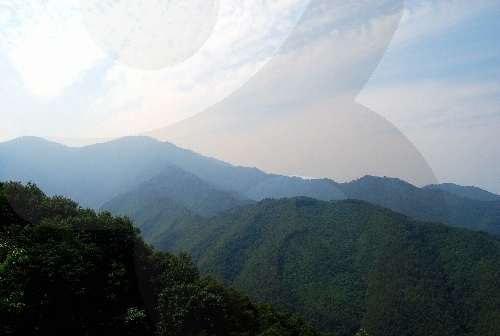
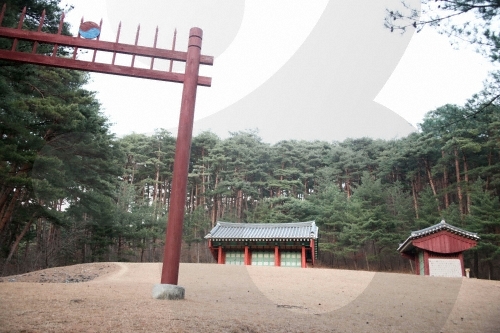
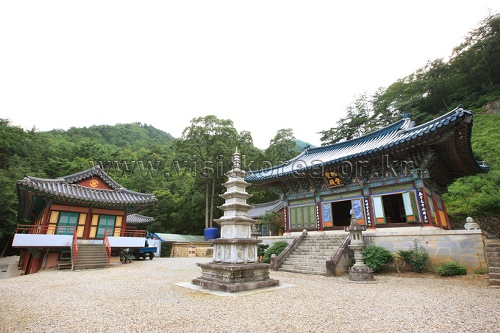

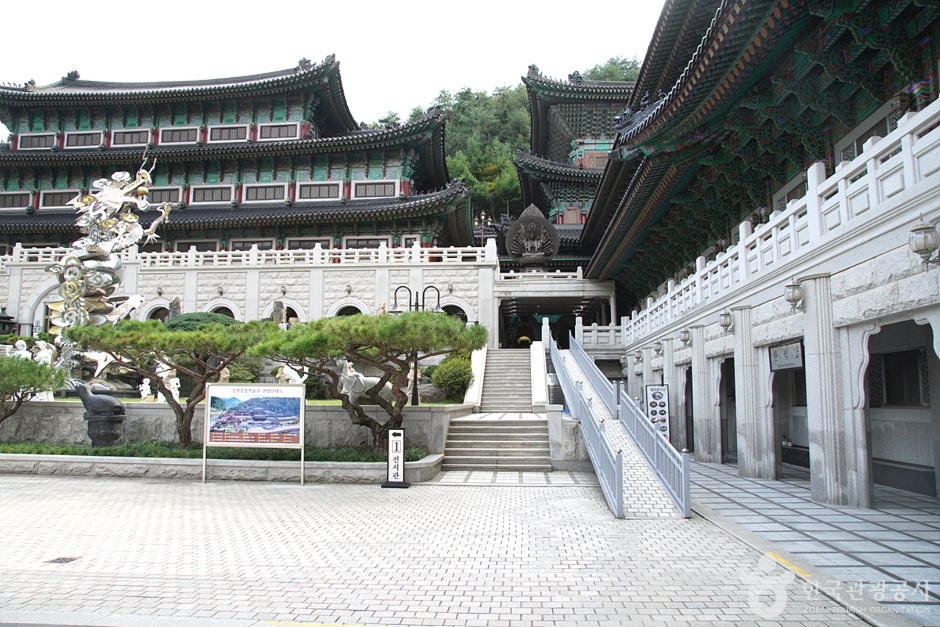
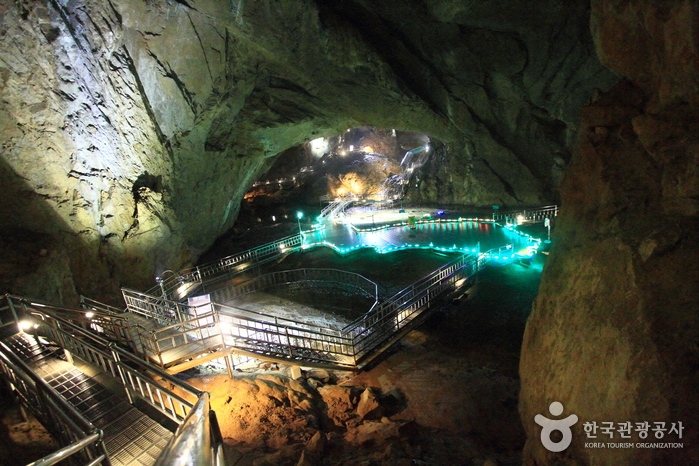
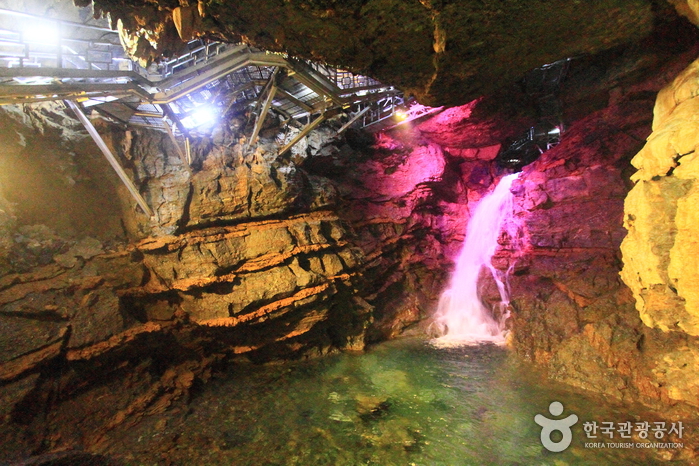
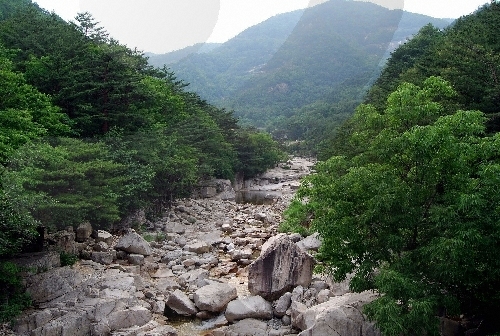
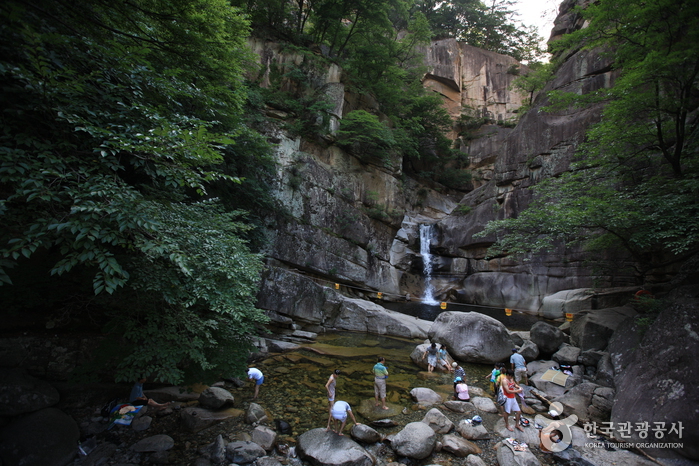
 English
English
 한국어
한국어 日本語
日本語 中文(简体)
中文(简体) Deutsch
Deutsch Français
Français Español
Español Русский
Русский